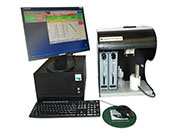DT1202 Particle size and Zeta potential
Acoustic and electro-acoustic spectrometer. Particle size distribution and zeta potential.
Acoustic and electro-acoustic techniques have significant advantages for characterizing particle size distribution and zeta potential when used in conjunction. As such, an optimum technique based on ultrasound should combine both acoustic and electro-acoustic spectroscopy together in one instrument. The Acoustic & Electro-acoustic Spectrometer DT-1202 is such an instrument.

The measuring chamber of DT-1202 contains both acoustic and electro-acoustic sensors. As a result, this instrument is capable of measuring ultrasound attenuation spectra for particle sizing. It measures Colloid Vibration Current as well for zeta potential. This instrument can perform acoustic and electro-acoustic measurements separately and independently. At the same time, the interpretation software is quite different for the individual spectrometers. However, it provides links between both measurements for improved characterization.
For instance, calculation of zeta potential from CVI requires information about particle size distribution. These parameters can be extracted from the acoustic measurement when acoustic and electro-acoustic spectrometers are combined together. The acoustic spectrometer provides, in this case, the required information about particle size. DT 1202 software implements this correction.
Options
The DT-1202 has a set of Options, which substantially extends this instrument’s capabilities. For instance, it can be supplied with 2 burettes for titration. This allows measuring zeta potential and particle size at different pH, surfactant concentration, and ionic strength. Aqueous and non-aqueous conductivity measurements are also optional. Non-aqueous conductivity is especially important for characterizing zeta potential in non-polar liquids. The Rheological option is suitable for characterizing longitudinal rheological properties, such as compressibility and bulk viscosity. Porous materials Option extends zeta potential capability for these types of samples. This option includes also measurement of porosity with high frequency aqueous conductivity probe.
Sample handling setup
The DT-1202 has a very flexible sample handling system that we have developed while dealing with complex concentrated systems for over 15 years. This flexibility has been achieved with a set of standard and optional Accessories. For instance, in the case of a stable system, minimum sample volume for zeta potential is 0.1 ml, and for particle size measurement – 15 ml.
There are more than 100 papers published by users of the DT-1200, 1201 and 1202 models during last 3 decades. These papers present applications of this instrument for characterizing particle size and zeta potential in a variety of complex systems. Section Application presents them organized in several groups. Section Newsletters presents our own studies of the particle size distributions and zeta potential with this instrument.
There are 5 US patents that describe several novel and patented aspects of this instrument:
- Dukhin A.S. and Goetz, P.J. “Particle size distribution and zeta potential using acoustic and electroacoustic spectroscopy“, patent USA, 6,109,098 (2000)
- Dukhin A.S. and Goetz, P.J. “Method and device for determining particle size distribution and zeta potential in concentrated dispersions“, patent USA, 6,449,563 (2002)
- Dukhin A.S. and Goetz, P.J. “Method for determining particle size distribution and structural properties of concentrated dispersions“, patent USA, 6,910,367 B1 (2005)
- Dukhin A.S. and Goetz, P.J. “Method for determining particle size distribution and mechanical properties of soft particles in liquids“, patent USA, 6,487,894 B1 (2002)
- Dukhin A.S. and Goetz, P.J. “Method for determining electric properties of particles in liquids by means of combined electroacoustics and complex conductivity measurements“, patent USA, 6,915,214 B2 (2005)
